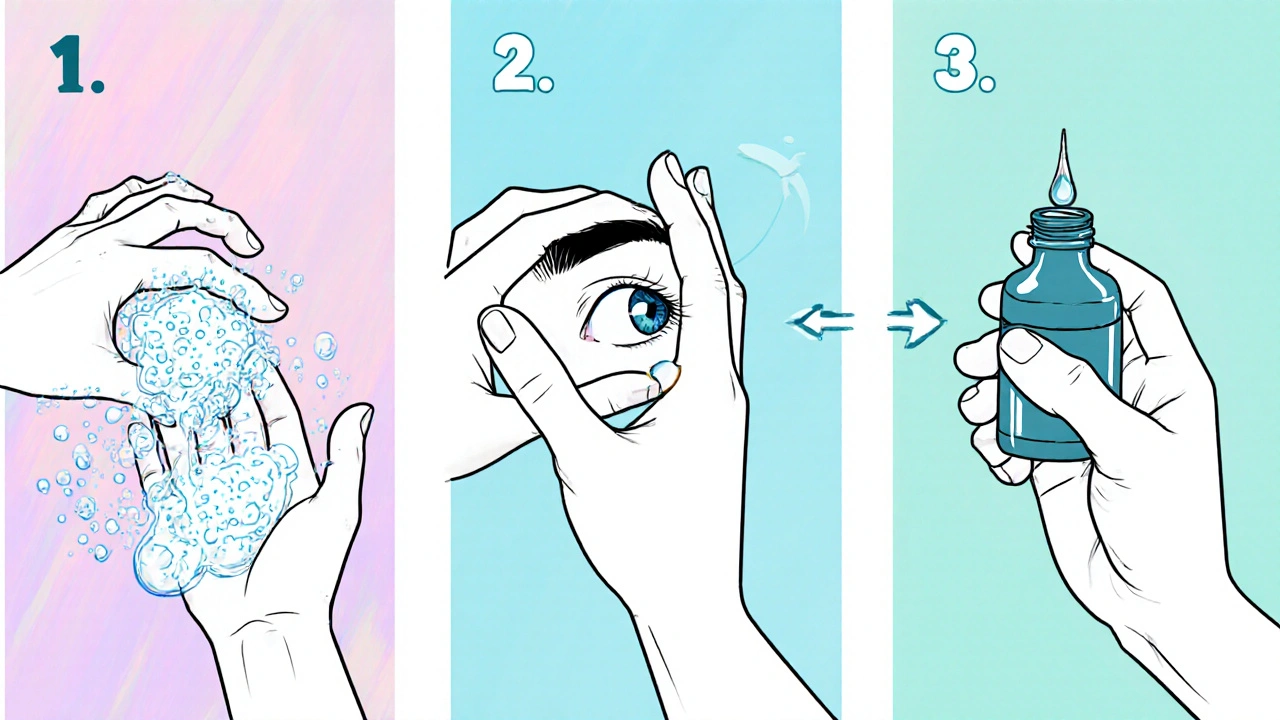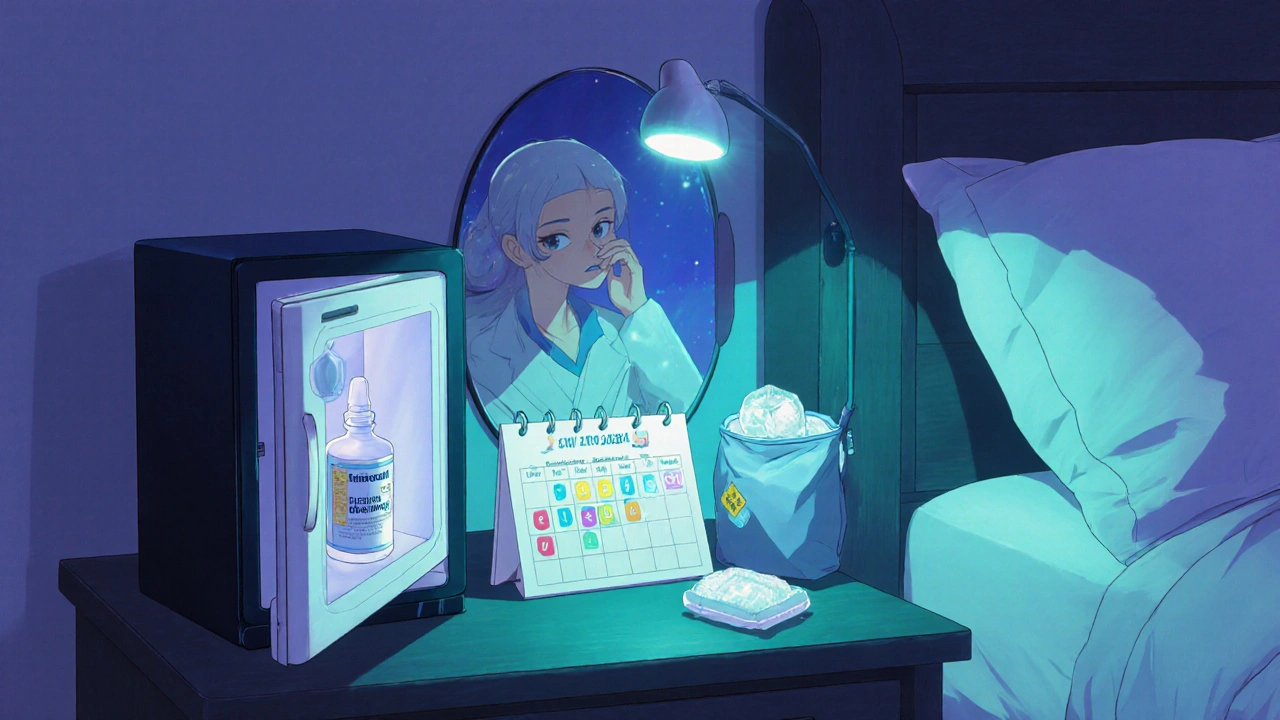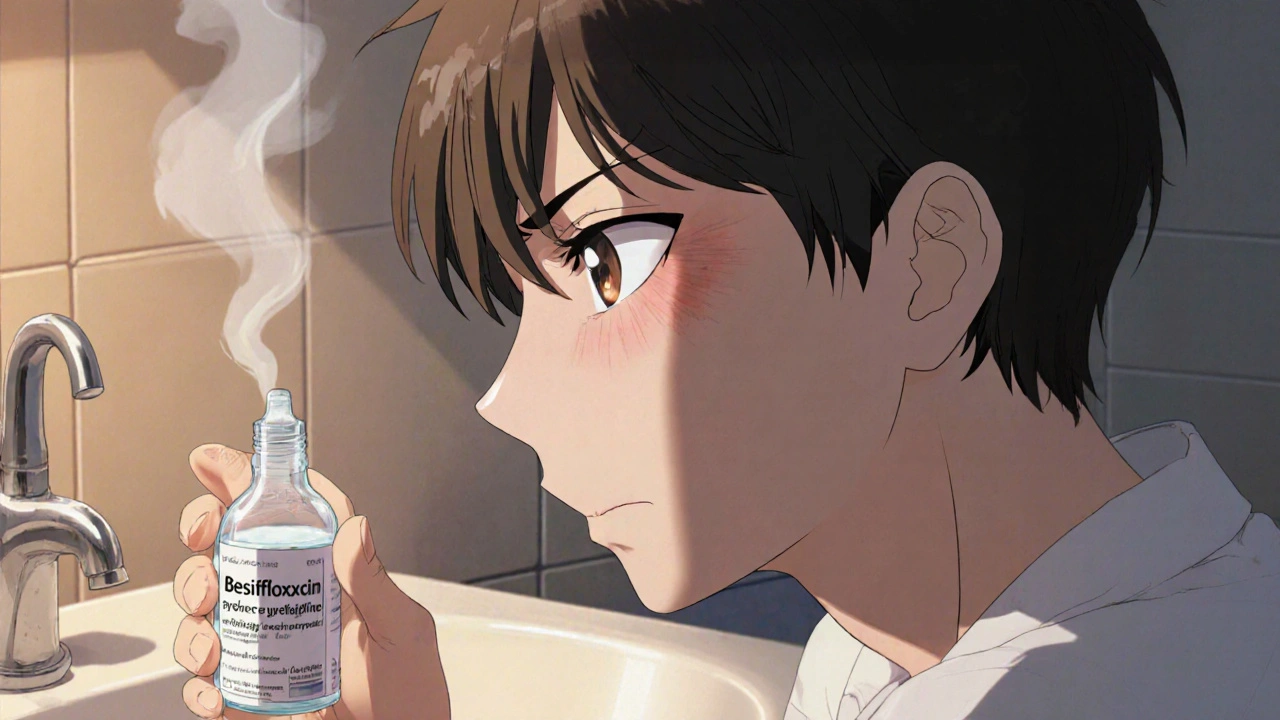Besifloxacin Dose Calculator
Your Dosing Schedule
Important Instructions
Key Tips:
- Wait 5 minutes between eyes to avoid cross-contamination
- Close eye for 1-2 minutes after application
- Press inner eye corner for 30 seconds to reduce absorption
- Store refrigerated after opening
Dealing with a painful eye infection can feel like a nightmare, especially when you’re not sure how to use the medication properly. This guide breaks down everything you need to know about Besifloxacin eye drops-from how they work to the little tricks that make the treatment painless and effective.
What Is Besifloxacin Eye Drops?
Besifloxacin eye drops is a topical fluoroquinolone antibiotic formulated as a sterile ophthalmic solution. It was approved by the FDA in 2009 and quickly became a go‑to for bacterial eye infections because it penetrates eye tissues better than many older drops.
How the Medication Works
Besifloxacin belongs to the Fluoroquinolone antibiotics. These drugs target bacterial DNA gyrase and topoisomerase IV, enzymes that bacteria need to copy their DNA. By blocking those enzymes, the bacteria can’t reproduce and the infection clears up.
The drug’s high affinity for the cornea means it stays where it’s needed, even if you blink a lot. That’s why doctors often prescribe it for Bacterial conjunctivitis and other ocular surface infections.
When Doctors Choose Besifloxacin
Typical scenarios include:
- Redness, swelling, and discharge that started suddenly.
- Confirmed bacterial culture (e.g., Staphylococcus aureus, Streptococcus pneumoniae).
- Failure of over‑the‑counter lubricants or steroid drops.
Because it’s a prescription‑only drug, you’ll need a doctor’s note. In Australia, most eye specialists and general practitioners can write it, and you can fill it at a local pharmacy or an online pharmacy that ships to Sydney.
Getting the Prescription - A Simple Checklist
- Schedule an eye exam. Bring a list of any current meds.
- Ask the doctor if Besifloxacin is appropriate for your infection.
- Confirm dosage: usually one drop in the affected eye(s) three times a day for seven days.
- Pick up the medication within 48 hours of the prescription to ensure potency.
Tip: Verify that the bottle says “sterile” on the label. That confirms it’s a sterile ophthalmic solution and not a contaminated product.

Step‑by‑Step: Using the Drops Correctly
- Wash your hands thoroughly with soap and water.
- Shake the bottle gently-don’t invert it.
- Tilt your head back slightly and pull down the lower eyelid to create a pocket.
- Hold the bottle about 1 cm (½ inch) from the eye. Press the tip to release one drop.
- Close your eye gently for 1-2 minutes. Avoid blinking hard, which can push the drop out.
- Press the inner corner of the eye (near the nose) with a clean finger for 30 seconds. This blocks the nasolacrimal duct and reduces systemic absorption.
- If you need to treat both eyes, wait at least 5 minutes before applying to the second eye to avoid cross‑contamination.
All of this can be done in under a minute. Consistency is key; missing a dose can give bacteria a chance to rebound.
Typical Dosage Schedule
| Day | Frequency (drops per day) | Typical Side Effects |
|---|---|---|
| 1‑3 | 3 (morning, afternoon, night) | Transient burning, mild stinging |
| 4‑7 | 3 (same schedule) | Redness may lessen, occasional itching |
| Post‑treatment (day 8+) | Stop | Rare: corneal ulceration (if misused) |
Managing Common Side Effects
Most patients notice a brief burning sensation when the drop first hits the eye. That’s normal and usually fades within seconds. If you experience any of the following, call your doctor:
- Severe pain or vision loss.
- Persistent redness beyond the first three days.
- Signs of an allergic reaction- swelling, hives, or difficulty breathing.
To soothe mild irritation, use preservative‑free artificial tears an hour after the antibiotic. Do NOT mix the two drops together; keep a 30‑minute gap.

Special Situations - What to Watch For
Contact lens wearers should remove lenses before applying the drops and wait at least 15 minutes before reinserting them. The antibiotic can cause lens material to become cloudy.
Pregnant or breastfeeding patients need a doctor’s clearance. Although animal studies show no major risk, the label advises caution.
If you’re on other eye meds-like steroids or antihistamine drops-ask your pharmacist about drug interactions. Besifloxacin can affect the absorption of other topical agents.
Tips and Tricks for Success
- Keep the bottle refrigerated after opening; the cooling slows degradation.
- Mark the days on a calendar-visual cues help you stay on schedule.
- Use a mirror for the first few applications to get comfortable with the technique.
- If you drop the medication on the cheek instead of the eye, discard that dose-don’t re‑use the bottle.
- Traveling? Pack the drop in a sealed plastic bag with a small ice pack to maintain temperature.
Frequently Asked Questions
How long does a bottle of Besifloxacin last?
A standard 0.5 mL bottle contains about 25 drops, enough for a full 7‑day course at three times daily. If you miss a dose, you still won’t run out before the regimen ends.
Can I use Besifloxacin for viral pink eye?
No. It targets bacteria only. Viral infections need supportive care-lubricants, cold compresses, and sometimes antiviral meds.
Is it safe to use the drops after eye surgery?
Your surgeon will decide. In many cases, Besifloxacin is prescribed post‑operatively to prevent bacterial contamination, but timing matters.
What should I do if I accidentally squeeze two drops?
It’s usually fine; the excess will drain out. Just continue with the scheduled doses-don’t double up the next time.
Can children use Besifloxacin?
Yes, pediatric use is approved for children older than one year, but the dose (one drop) stays the same. Always follow the doctor’s exact instructions.
With the right technique and a few practical habits, you can clear up an eye infection quickly and avoid the hassle of re‑visits. Keep this guide nearby the next time your doctor writes a prescription for Besifloxacin eye drops, and you’ll be back to clear vision in no time.



Abhishek Kumar
October 23, 2025 AT 12:37Looks like another generic eye‑drop guide.
hema khatri
October 26, 2025 AT 18:33Wow!!! This guide on Besifloxacin is super helpful for all of us Indians battling eye infections-let’s spread the word!!! 🇮🇳
Jennell Vandermolen
October 30, 2025 AT 05:53Thanks for sharing, the step‑by‑step section really clarifies the technique. It’s great to see practical tips included.
Mike Peuerböck
November 2, 2025 AT 17:13Thank you for the detailed steps; they cover the essential aspects of proper administration.
First, washing hands cannot be overstated, as any contamination can introduce new pathogens to the ocular surface.
Second, shaking the bottle gently is advisable, but inverting it could compromise the sterile formulation.
When tilting the head, creating a lower eyelid pocket ensures the drop lands directly on the cornea rather than spilling.
Maintaining a distance of about one centimeter reduces the risk of physically touching the eye with the nozzle.
Closing the eye for one to two minutes allows the medication to spread evenly across the ocular surface.
Applying pressure on the inner canthus for thirty seconds is a proven method to obstruct the nasolacrimal duct and limit systemic absorption.
If both eyes require treatment, spacing the applications by at least five minutes prevents cross‑contamination.
Consistency in timing-morning, afternoon, and night-optimizes the drug’s bactericidal activity.
Missing a dose may give surviving bacteria a chance to repopulate, potentially leading to a relapse.
Patients often report a transient burning sensation; this is a pharmacodynamic effect rather than an adverse reaction.
Should the burning persist beyond a few seconds, a preservative‑free artificial tear can be used after a thirty‑minute interval.
Contact lens wearers must remove their lenses before instillation and wait fifteen minutes before reinserting them to avoid clouding.
Refrigerating the bottle after opening extends its stability, as lower temperatures slow degradation of the active compound.
Marking each day on a calendar provides a visual cue that helps maintain adherence throughout the seven‑day course.
Finally, any signs of severe pain, vision loss, or allergic reaction warrant immediate medical attention.
Simon Waters
November 6, 2025 AT 04:33I wonder if big pharma is pushing this drop just to sell more stuff.
Danielle St. Marie
November 9, 2025 AT 15:53Honestly, only the uninformed would settle for a basic guide like this 🙄📚.
keerthi yeligay
November 13, 2025 AT 03:13Ths is vry helpful thx
Peter Richmond
November 16, 2025 AT 14:33The guide provides practical advice for proper use of Besifloxacin.